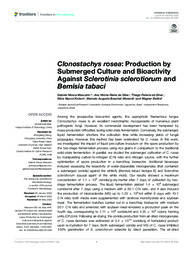Clonostachys rosea: production by submerged culture and bioactivity against Sclerotinia sclerotiorum and Bemisia tabaci.
Clonostachys rosea: production by submerged culture and bioactivity against Sclerotinia sclerotiorum and Bemisia tabaci.
Author(s): MASCARIN, G. M.; SILVA, A. V. R. da; SILVA, T. P. da; KOBORI, N. N.; MORANDI, M. A. B.; BETTIOL, W.
Summary: Abstract: Among the prospective biocontrol agents, the saprophytic filamentous fungus Clonostachys rosea is an excellent necrotrophic mycoparasite of numerous plant pathogenic fungi. However, its commercial development has been hampered by mass production difficulties during solid-state fermentation. Conversely, the submerged liquid fermentation shortens the cultivation time while increasing yields of fungal propagules. However, this method has been overlooked for C. rosea. In this work, we investigated the impact of liquid pre-culture inoculum on the spore production by the two-stage fermentation process using rice grains in comparison to the traditional solid-state fermentation. In parallel, we studied the submerged cultivation of C. rosea by manipulating carbon-to-nitrogen (C:N) ratio and nitrogen source, with the further optimization of spore production in a benchtop bioreactor. Additional bioassays included assessing the bioactivity of water-dispersible microgranules (that contained a submerged conidia) against the whitefly (Bemisia tabaci biotype B) and Sclerotinia sclerotiorum (causal agent of the white mold). Our results showed a maximum concentration of 1.1 × 10 9 conidia/g-dry-matter after 7 days of cultivation by two-stage fermentation process. The liquid fermentation yielded 1.4 × 10 9 submerged conidia/ml after 7 days using a medium with a 50:1 C:N ratio, and it also induced the production of microsclerotia (MS) up to 1.35 × 10 4/ml within 6 days with 10:1 C:N ratio; both media were supplemented with dextrose monohydrate and soybean meal. The fermentation batches carried out in a benchtop bioreactor with medium 50:1 C:N ratio and amended with soybean meal rendered a production peak on the fourth day, corresponding to 1.11 × 10 9 conidia/ml and 4.35 × 10 8 colony forming units (CFU)/ml. Following air-drying, the conidia production from air-dried microgranules of C. rosea biomass was estimated at 3.4 × 10 10 conidia/g of formulated product upon re-hydration for 7 days. Both submerged conidia and MS of C. rosea inhibited 100% germination of S. sclerotiorum sclerotia by direct parasitism. The air-dried submerged conidia exhibited a suppressive activity on sclerotia (88% mycoparasitism) and early whitefly nymphs (76.2% mortality) that rendered LC 50 values of 3.2 × 10 4 CFU/g soil and 1.5 × 10 7 CFU/ml, respectively. Therefore, the submerged liquid culture of C. rosea may offer a feasible and cost-effective method for its large-scale production, alleviating critical constraints to their commercial use while providing an additional tool for management of B. tabaci and S. sclerotiorum.
Publication year: 2022
Types of publication: Journal article
Unit: Embrapa Environment
Observation
Some of Embrapa's publications are published as ePub files. To read them, use or download one of the following free software options to your computer or mobile device. Android: Google Play Books; IOS: iBooks; Windows and Linux: Calibre.
Access other publications
Access the Agricultural Research Database (BDPA) to consult Embrapa's full library collection and records.
Visit Embrapa Bookstore to purchase books and other publications sold by Embrapa.

